It’s winter in Maryland. In fact, it’s so much winter I shoveled 10 inches of snow off my driveway this morning. Fortunately, I had company. It wasn’t the kind of company that picks up a shovel and helps out, but still, the American robins darting back and forth over my head were still welcome (if surprising and surprisingly quiet) snow day companions.
Become a Member
Make a lasting impact for nature when you join The Nature Conservancy
“You know,” I said to them as I leaned on my shovel to watch about 25 birds flock together in my neighbor’s oak. “I think y’all are a little early—aren’t you supposed to be the first harbingers of spring?”
We’re not even a month past the first day of winter in the northern hemisphere. Spring is definitely not here. So why are the robins? Shouldn’t they be sunning themselves in warmer climes?
The short answer: as long as there’s food, American robins—true to their name Turdus migratorius (“the wandering thrush”)—kind of spend their winters coming and going as they please.
Robin Migration (AKA Robin Wandering)
Robins do migrate—but they don’t necessarily follow a more or less straight line from north to south in the fall, then repeat the journey south to north in the spring. In the fall and winter, when the ground freezes, robins lose access to their meal of choice: worms, insects (adult and larval) and (occasionally) snails. That’s when they turn to their winter diet staple: mostly fruit, mostly berries.
The folks at Journey North, a project tracking robin movements run by the University of Wisconsin-Madison, put it this way, “Some robins retreat all the way to southern Texas and Florida (in fact, some of the largest winter flocks documented by the Christmas Bird Count gather in sunny St. Petersburg, Florida), but others winter as far north as they can find berries. So they have an enormous winter range. Robins do migrate, but it has more to do with food sources than with being faithful to the same places year over year.”
In that way American robins are somewhat akin to teenage boys—they tend to go where the best (or most abundant or most easily accessible) food is, stay until it’s depleted, and then move on.
So as long as there are enough berries and other fruits to sustain them, you may see robins off and on throughout the winter across much of North America.
Forget the birdseed though. Robins’ digestive systems, unlike sparrows or other so-called feeder birds, aren’t built for dealing with seed, and their beaks aren’t built for cracking things open. Robin beaks are built for snapping up worms, catching insects, and plucking berries and other fruits. In the winter, a flock of robins can strip a holly bush with impressive speed and efficiency, and very little—if any—violent robin-on-robin aggression.
Food is also one of the reasons that robins, notoriously territorial and aggressive in breeding season, tend to gather and travel in flocks in the fall and winter. Numbers are good for defense, and also for spotting food—if one robin happens on a holly tree full of bright, ripe berries, the whole flock can partake. And then move on.
The tendency of robins to flock in winter may also be one of the reasons people seem to notice them—birds in large numbers tend to stand out when they’re gathered in leafless trees. (That and the beautiful red breast that is sometimes the only splash of color in a winter landscape that looks practically lunar in relentless shades of February white and gray.)
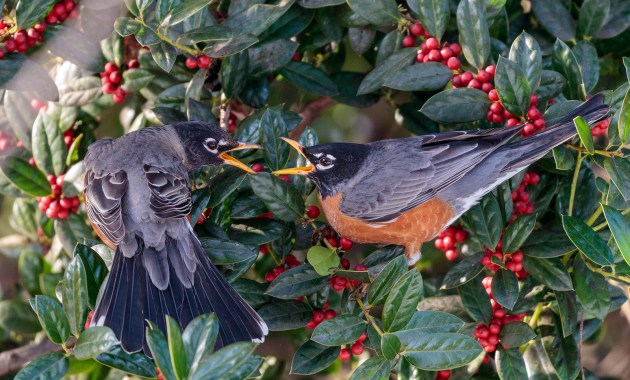
How do Robins Survive the Cold?
Robins are outfitted to survive huge temperature variances. In fact, hot weather seems to stress them more than cold.
If an American robin is healthy, has enough to eat, and is able to main its feathers, the temperature next to its body stays around 104 F—regardless of how cold it is in the world outside. It really is all about those feathers. (And the legs and feet.)
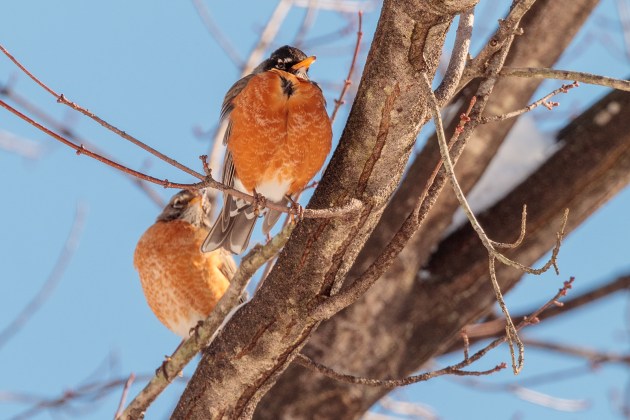
Robins, like most birds, have layers of feathers that perform different functions. When temperatures drop, robins puff the fine, downy feathers closest to their bodies to keep heat in, cold out. The outer feathers act like a kind of overcoat, shedding water and moisture and helping to regulate the bird’s temperature. (It’s an adaptation not limited to robins. Most birds with down feathers fluff them to regulate body heat).
The anatomy of a robin’s (and other bird species) also contributes to their cold adaptations. The bird experts over at the Cornell Lab explain it very well. The simplified version is that “most birds don’t succumb to frostbite because there is so little fluid in the cells of their feet, and their feet are mostly tendons and bones with little muscle or nerve tissue.”
So while blood does flow to their legs and feet, most birds (including robins) benefit from a very fast circulatory system and a “countercurrent heat exchange system.” Because bird legs are thin, the vessels that move blood from the heart to the feet and back again are very close together. That proximity means, per Cornell, “blood flowing back to the body is warmed by blood flowing to the feet. The newly cooled blood in the feet lowers heat loss from the feet, and the warmed blood flowing back into the body prevents the bird from becoming chilled.”
Robins: The Tell-Tale Birds of Spring
If robins are around in winter, why have they always been associated with the beginning of spring in the U.S.? Most likely it has to do with ground thaw, snow melt, and territorial behaviors like singing, worm hunting and nest building. But mostly, it’s the singing.
According to Journey North, which has a fantastic Q+A section I highly recommend for the robin-curious, “the robin’s song remains a reliable indicator that the first wave of spring migration has reached you. This song is one of the first signs that robins are switching from winter behavior to courtship and nesting behaviors associated with spring.”
Robins tend to move north as the ground thaws. The availability of high protein prey, especially worms that emerge with warmer, often wetter weather, is when a robin’s thoughts turn to procreation. And that’s the end of the cooperative fall and winter behaviors.
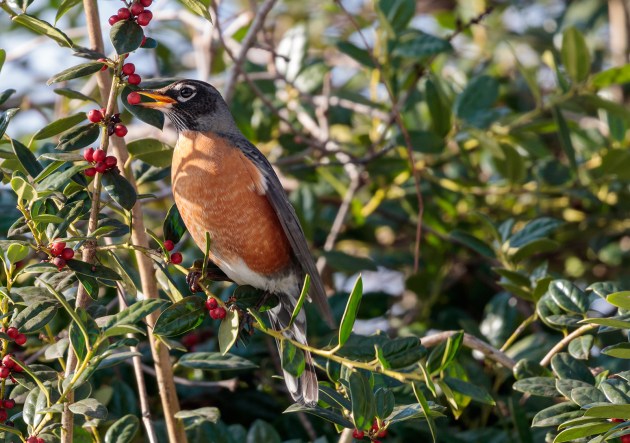
Which is one of the reasons many robins (primarily males) may stay through harsher winters instead of booking it to St. Petersburg: first access to the choicest nesting grounds. Breeding season is when robins also become more visible with mating displays, nest-building and a lot of time on the ground hunting for the tastiest worms. Until then, they’re all about the berries.
You Can Help Robins with Science from Your Own Backyard
Like many species, including other birds, scientists are starting to see some changes in robin behavior that is likely attributable to climate change. One study of American robins migrating to and from Canada’s boreal forest, showed that they’re beginning to journey south on average about 12 days earlier than in past years, or five days earlier per decade since 1994.
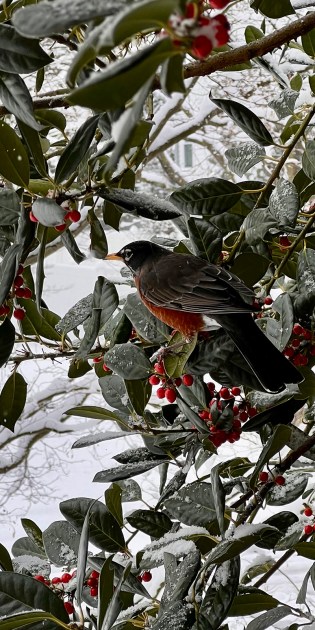
If you want to help scientists studying birds, there are several ways to contribute your observations (not just for robins, but for many of the species you can see outside your windows).
Journey North
You can submit your robin observations directly on the Journey North site (and check out their other migration-related citizen science projects). They also have 2025 maps tracking sightings so you can see where American robins (and other signs of spring) are being observed and follow along (and contribute to) the wanderings of Turdus migratorius.
Cornell Lab of Ornithology
The Cornell Lab has a number of different ways you can contribute to science for birds. Your sightings tracked on eBird (free) contribute to worldwide data for birding, science, and conservation. Want to know what birds are being seen in your neighborhood, eBird has a feature for that. If you’re new to birding, check out their genius birding ID app, Merlin.
You can also contribute to Project FeederWatch (requires subscription) by counting birds at your feeder from November through April. Your observations help scientists monitor changes in the abundance and distribution of birds, including the influence of changes in habitat, disease, and climate.
And mark your calendars for the 2025 Great Backyard Bird Count (February 14-17). Spend time in your favorite places watching birds—then report them to Cornell! It’s easy to participate, “in as little as 15 minutes notice the birds around you. Identify them, count them, and submit your counts to help scientists better understand and protect birds around the world. You can see the results from 2024 here.
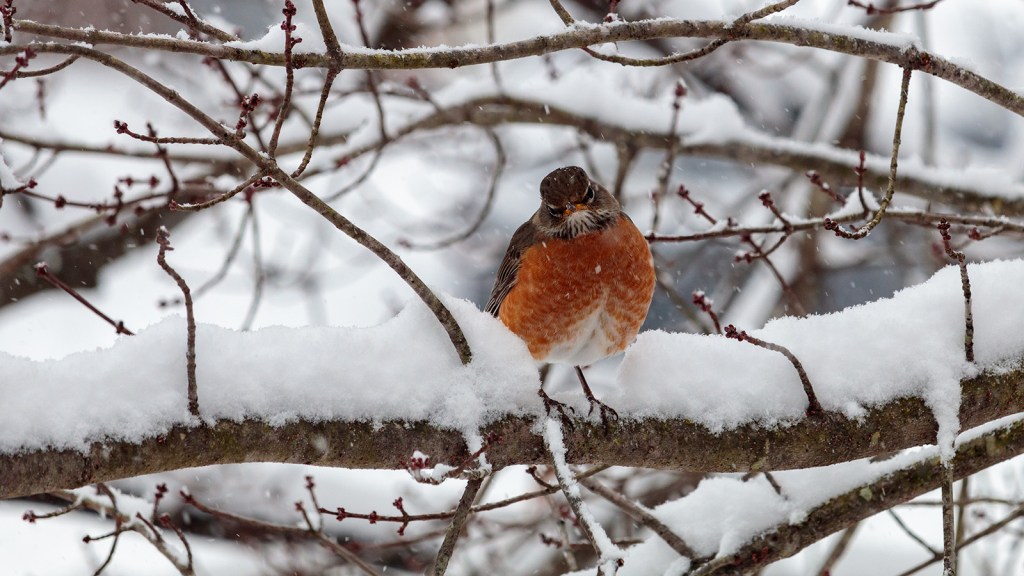



We’re seeing 6 to 8 robins at our heated water dish. They’ve been around for about 10 days. They seem to enjoy peanuts in the shell. We put out raisins and cut up apples but no takers. My husband saw them go into one of the birdhouses. Is that common? We enjoy all the birds.
My husband and I saw a flock of robins on the road outside of Angelica, NY on Feb. 13th. We had never seen a robin, let alone a flock, this early. There were hundreds of them! We had to slow down because they were feeding along the road. We were concerned because we have had frigid temperatures. This article helped us understand that they know what they are doing!
I saw a robin Feb 10th in Warren MI
Hundreds of Robin’s came thru BedfordTX while we are having rare below freezing temps and snow. Feb 15, 2021.
On February 17th, during the worst winter storm here in Garland, Texas (outside of Dallas), my home was overrun by hundreds if not a thousand American Robins. Most of them were perched in my neighbors trees across the street. They seemed to coordinate swooping down on the snow covered yaupon holly trees in my yard to eat the berries. It was like a scene out of Hitchcock’s “The Birds” movie flying into the bay glass skylight windows. Included in the same group of birds were Cedar Waxwings too (on a smaller scale but very unusual I thought to see them together). After about 45 minutes of eating and resting in the trees, they moved on. I have lived here 35 years and have never witnessed anything like it. The cedar waxwings are not unusual to see in the winter devouring the berries. We never see robins in the winter months.
Plano, Texas – We have been thrilled to have a huge group of robins in our fair city for a week now even though we’ve had the coldest snowy days in 71 years! From all over our city, flocks of 100s of male robins have been seen! I’ve lived here 44 years and have never seen them in large numbers!!
We live in Texas North Dallas. Before this big winter storm hit us the robins were everywhere in big flocks. Everyone was commenting on this. Many started feeding them with Meal Worms. I don’t think I have ever seen that many at a time. Did the robins come because of the artic air coming. It is still freezing temps out side during the day. I have not seen flocks since all the snow came. Is this all natural for them.
Thank you
Marilyn
We’ve always had a few robins around but here in East Texas, in the midst of the Texas snowpocalypse of 2021, we’ve had 15-20 at a time for the last 4-5 days. I read that they don’t eat bird seed and have trouble digesting it but these are gobbling it up like crazy. Will they be okay??? I’ve put out over 100 lbs of food for a wide variety of birds during all this snow and ice, along with fresh water, to try to help them. Many in our community are reporting lots of frozen birds but my backyard visitors seem to be doing well.
I have had robins for two weeks. They stripped all of the hollys in the neighborhood and then the snow came. I keep food and water out so they have stayed. Today I could count 30+. Between the feed tray and the tree. It is warming today so I’ll be interested to see if they stay. There seem to be a few less brightly colored but not sure if they are females.
Feeding and watching birds in Louisiana. Red birds, bluejays,
Mourning doves, etc. Today,02/18/21
the yard was invaded by blackbirds?
Fruit-n-Nuts, black oil seeds, last bought some millet & black oil seeds,
due to the cold and number of birds.
Thought the corn chops might help keep them warm. Fill the squirrels.
It Feb 18, 2021 near Fort Worth Texas. I have about 30+ robins in and around my yard. I have observed them eating berries, eating snow and looking around for any insects. It has been the most amazing thing because I have never seen so many all at once.
Now we know whats going on, Here in Oklahoma City 2/15/21 – 2/18/21 Just had three big snow storms with temps as low as -10 with wind chills -25. And our home and trees are like something out of Hitchcock’s Birds with Robins. Flocks of 25 or more everywhere all trying to attack the several holly bushes. Just an awesome sight and all the red berries are gone. Took some great pics .
I live in the Dallas/North Texas area. There are hundreds of Robins in flocks landing in my yard and nextdoor yard. The neighbor’s dense, berry filled tall shrub caused a lot of noise thus morning. Then caused a big mess on the snow in my front and back yard. Needless to say, I loved seeing this very unusual activity.
This was very interesting. Very educateing information, never knew that a robin temp. was that high as Oklahoma has cold winters. I too thought that when you first seen them that spring was right around the corner.
Had a hugh flock of Robins today engulfed a berry ladened Yopon tree in backyard. Completely ate every berry. I have video of this event. I have never witnessed this before. February 17,2021, Mesquite,Tx